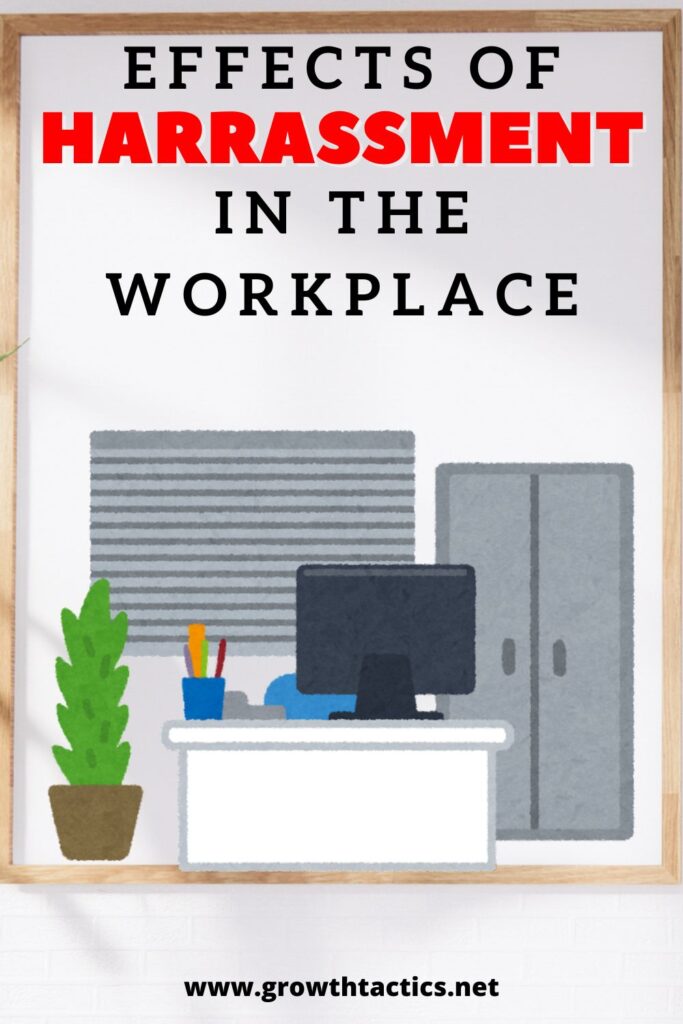Harassment has no place in our workplaces. When it happens, the impact can be severe. The effects reach far beyond just the person being targeted. Harassment can damage the entire work environment.
Everyone in the office feels the strain. Productivity drops, morale sinks, and health issues arise. Let’s explore the harmful effects of harassment in the workplace and why it’s crucial to address it.
Jump To Section
Types of Harassment in the Workplace
Harassment in the workplace can take many forms. Let’s look at some common types and what they involve:
General Workplace Harassment
This type of harassment includes any unwanted behavior that makes someone feel uncomfortable, intimidated, or threatened. It can be verbal, like insults or threats. It can also be non-verbal, such as offensive gestures or inappropriate images.
Workplace Sexual Harassment
Sexual harassment in the workplace involves any unwelcome sexual advances, requests for sexual favors, or other verbal or physical conduct of a sexual nature. This could be anything from inappropriate comments about someone’s appearance to more severe actions like unwanted touching or even explicit emails.
Racial Harassment
This occurs when someone experiences unjust treatment or offensive behavior based on their race or ethnicity. It can involve racial slurs, derogatory comments, or jokes that create a hostile work environment.
Disability Harassment
Disability harassment includes any unfavorable treatment or offensive behavior directed at an individual due to their disability. This might involve mocking someone’s condition, ignoring their accommodation needs, or making inappropriate remarks about their capabilities.
Age Harassment
Age harassment is mistreatment based on someone’s age. This form of harassment often affects older employees but can impact younger workers as well. Examples include age-related jokes, comments questioning someone’s ability to perform their job because of their age, or discriminatory practices in hiring and promotion.
Examples of Each Type
Imagine a colleague constantly making jokes at your expense, making you feel small and undervalued. That’s workplace harassment.
Now think about a coworker who keeps making suggestive comments or sending you inappropriate messages. That’s workplace sexual harassment.
Consider someone making offensive jokes about your race or mocking your accent. That qualifies as racial harassment.
If people in your office belittle you because of your disability, ignoring your needs or making rude comments, that’s disability harassment.
Lastly, think about jokes or comments that target you because of your age, suggesting you’re too old or inexperienced for your role. This is age harassment.
All these behaviors are harmful and unacceptable.
Negative Impact on Employees
Harassment has serious effects on employees. Let’s explore some of these impacts:
Self-Esteem and Mental Health
When someone faces harassment, their self-esteem often takes a hit. They may start doubting their abilities. Anxiety and depression can become daily struggles. Feeling constantly on edge drains mental energy, making it hard to focus on work.
Effects on the Workplace:
- Reduced productivity and quality of work.
- Higher likelihood of mistakes due to distracted employees.
- Lower overall morale as stressed employees influence their colleagues.
Physical Health Consequences
Believe it or not, harassment can affect physical health too. Constant stress can lead to headaches, high blood pressure, and even sleep disorders. It’s like carrying around a heavy weight all the time, and your body eventually starts to show the strain.
Effects on the Workplace:
- Increased absenteeism due to health issues.
- Higher healthcare costs for the company.
- Reduced workplace energy and enthusiasm.
Emotional Wellbeing
Emotionally, the toll is significant. Victims may feel isolated and unsupported. They might become withdrawn and lose interest in their work. Everyday tasks start to feel overwhelming, making it hard to enjoy anything at all.
Effects on the Workplace:
- Decline in team cohesion and collaboration.
- Increased conflict among team members.
- A more tense and negative work atmosphere.
Increased Absenteeism
It’s no surprise that people being harassed often take more sick days. They might dread coming to work, which leads to more absenteeism. This not only affects their performance but also disrupts team projects and deadlines.
Effects on the Workplace:
- Missed deadlines and delayed projects.
- Overburdened employees picking up the slack from absent colleagues.
- Increased stress for everyone on the team.
Turnover and Retention Issues
When harassment persists, employees may choose to leave rather than endure the hostile environment. This high turnover harms the company both financially and culturally. Good talent walks out the door, and the morale of those who stay takes a dive.
Effects on the Workplace:
- Loss of valuable skills and knowledge.
- Costly and time-consuming recruitment processes.
- Damaged company reputation, making it harder to attract top talent.
In short, harassment doesn’t just affect the person targeted. It creates ripples that impact the entire workplace. Addressing these issues is crucial for a healthy, productive work environment.
Legal Implications and EEOC Guidelines
Understanding the Laws
Navigating the laws around workplace harassment can be tricky, but it’s essential for both employees and employers. When harassment happens, it isn’t just a personal issue; it’s a legal one too.
Various laws protect employees from harassment, ensuring they have a safe work environment. Familiarizing yourself with these laws helps you understand your rights and obligations.
The Role of the EEOC
You might wonder, what exactly is the EEOC? The Equal Employment Opportunity Commission, or EEOC, enforces federal laws that make harassment illegal.
They cover all kinds of harassment, from racial and sexual harassment to disability and age discrimination. Knowing that the EEOC has your back can be reassuring.
Filing a Complaint
If you experience harassment at work, you have the right to file a complaint with the EEOC. This process can feel daunting, but you don’t have to navigate it alone.
The EEOC guides you every step of the way. They review your case, conduct investigations, and, if necessary, take legal action on your behalf. This ensures you aren’t left to deal with the situation by yourself.
Employer Responsibilities
Employers have a significant role in preventing and addressing harassment. They must establish clear policies and procedures for reporting harassment.
Training programs for all employees, especially new hires, create a culture of awareness and respect. Employers are also required to investigate complaints promptly and thoroughly. Ignoring these responsibilities can lead to hefty fines and legal troubles.
Why Compliance Matters
Following EEOC guidelines and the law isn’t just about avoiding penalties. It’s about creating a positive, inclusive work environment where everyone feels safe and respected. When employers take harassment seriously, employees are happier, more productive, and more committed to their jobs.
What You Can Do
Stay informed about your rights and the processes in place to protect you. Encourage your employer to provide training on harassment and ensure there’s a clear procedure for reporting issues. Remember, standing up against harassment not only helps you but also creates a healthier work environment for everyone.
In simple terms, understanding the legal implications and EEOC guidelines equips you to take action against harassment effectively and supports a workplace where everyone can thrive.
Strategies to Prevent Workplace Harassment
Creating a respectful work environment begins with understanding and proactively preventing harassment. Here are some practical strategies to help you foster a positive, harassment-free workplace.
Establish Clear Policies
Make sure your company has a comprehensive harassment policy in place. This policy should clearly define what constitutes harassment and outline the procedures for reporting it. Share this policy with all employees, ideally during onboarding and through regular reminders.
Provide Training
Conduct regular training sessions to educate employees about harassment. Use these sessions to cover:
- Different types of harassment (sexual, racial, disability, etc.)
- How to recognize and report harassment
- The consequences of harassing behavior
Using real-life scenarios can make the training more relatable and effective.
Encourage Open Communication
Promote an environment where employees feel comfortable discussing their concerns. Encourage them to speak up if they experience or witness harassment. Let them know that their concerns will be taken seriously and handled confidentially.
Lead by Example
Leadership sets the tone for workplace culture. Managers and supervisors should model respectful behavior and take immediate action if they observe or are informed about harassment. This shows employees that harassment will not be tolerated.
Implement a Reporting System
Have a clear, accessible system for reporting harassment. This could be an anonymous hotline, an online form, or a designated HR contact person. Make sure employees know how to use it and feel assured that their complaints will be investigated promptly and impartially.
Support Affected Employees
If an employee reports harassment, offer them support throughout the investigation process. This could include providing counseling services, adjusting their work situation, or simply lending a sympathetic ear.
Take Immediate and Fair Action
When harassment is reported, act quickly. Conduct a thorough investigation and take appropriate disciplinary measures if necessary. Make sure all actions taken are fair and in line with your company’s policy.
Foster a Positive Work Culture
Encourage team-building activities and opportunities for employees to get to know each other in a positive setting. A strong, cohesive team is less likely to tolerate harassing behavior and more likely to support one another.
Regularly Review Policies and Procedures
Don’t let your harassment policies gather dust. Regularly review and update them to reflect new laws, technologies, or shifts in the workplace culture. This keeps your policies relevant and effective.
Encourage Bystander Intervention
Train employees on how to intervene safely and effectively when they witness harassment. Empowering bystanders can stop harassment in its tracks and show everyone that your workplace doesn’t tolerate such behavior.
By adopting these strategies, you can create a workplace where respect and dignity are the norms. Remember, preventing harassment isn’t a one-time task; it’s an ongoing effort that requires commitment from everyone in the organization. Let’s work together to make every workplace safe and welcoming!
Addressing Harassment When It Occurs
Dealing with harassment when it happens is crucial for maintaining a positive workplace. If you experience or witness harassment, it’s important to take steps to address it right away.
Speak Up
First, speak up. If you feel safe, let the person know their behavior is unacceptable. Sometimes people don’t realize their actions are harmful. A simple statement like, “I don’t appreciate that comment,” can make a big difference. It sets a clear boundary and can stop the behavior immediately.
Document Everything
Next, document everything. Keep a record of what happened, when it happened, and who was involved. This includes dates, times, places, and any witnesses. Documentation helps you remember the details and supports your case if you need to report the incident.
Report the Harassment
Report the harassment according to your company’s procedures. This could be through an anonymous hotline, an online form, or directly to your HR department. Make sure you share all the details from your documentation. Trust that your report will be taken seriously and investigated promptly.
Seek Support
Seek support. Harassment can be very upsetting, so it’s important to talk to someone you trust. This could be a friend, family member, or counselor. Companies often have resources available, like employee assistance programs, that offer professional support.
Follow Up
Lastly, follow up. If you don’t see any action taken, check back with HR to see what’s happening with your report. It’s your right to know that the issue is being addressed. This step shows that you are serious about creating a safe work environment for everyone.
By taking these actions, you not only protect yourself but also help create a culture where harassment is not tolerated.
Conclusion
Addressing workplace harassment is a shared responsibility that benefits everyone. Employers must play a critical role in shaping a culture grounded in respect and dignity.
By establishing clear policies, providing regular training, and encouraging open communication, you can create an environment where harassment is less likely to occur. Taking proactive measures shows your commitment to the well-being of your employees and fosters a positive, productive workplace.
For those who experience or witness harassment, taking swift action is essential. Speak up if you feel safe, document incidents, and report harassment according to company procedures.
These steps protect you and help create a safer environment for everyone. Seek support from trusted individuals or counseling services to help you navigate through the situation. Follow up on reports to ensure your concerns are being addressed and resolved.
Everyone deserves to work in a safe and respectful environment. By working together, with employers creating protective measures and individuals taking necessary action, we can prevent harassment and promote a culture of mutual respect. Let’s commit to making our workplaces safe and welcoming for all.








